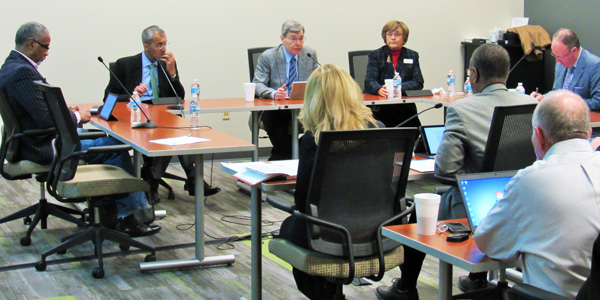By Amanda Durish Cook
The Human Resources Committee of MISO’s Board of Directors is considering a 2016 executive incentive plan that would slash potential bonuses by more than 30%.
During a Jan. 24 conference call, the committee suggested MISO executives receive 68.5% of a possible discretionary bonus for last year because of incomplete queue reform, a failure to implement seasonal and locational aspects into the Planning Resource Auction, capital budget overspending and a market funding efficiency rating that showed room for improvement.
According to MISO’s 2015 Form 990 filing, incentives outpace base salary for the RTO’s three highest paid executives.
CEO John Bear was the most highly compensated, taking in a $709,872 base salary and $1.1 million in incentives. Executive Vice President of Transmission and Technology Clair Moeller came in second with a salary of $363,189 and incentives worth $401,131.
Stephen Kozey, senior vice president of compliance services and one of MISO’s original employees, earned $362,681 in salary and $372,888 in bonuses. Other vice presidents earned an average of $503,000 and $157,000 in incentives.
MISO spent $143 million on salaries, compensation and benefits in 2015, compared with $130 million a year earlier.
The RTO currently charges a $0.34/MWh administrative rate, which covers salaries and benefits in addition to fees for third-party consultants and computer services.
Greg Powell, MISO vice president of human resources, said that despite a shortfall that cut into bonuses, MISO’s market funding efficiency score of 95.8% demonstrated the best performance to date. The RTO defines market funding efficiency as the alignment between financial transmission rights, the day-ahead market and the real-time market.
Bear said MISO could have done a better job forecasting capital spending last year, with the RTO overspending its $31 million budget by $2 million. In comparison, MISO overran its $225 million operating budget by $2.2 million.
MISO was also unable to implement interconnection queue reform and seasonal and locational constructs for the 2017/18 PRA during 2016.
Bear thought the stakeholder process was sufficient, but he acknowledged that MISO could work more with its Independent Market Monitor’s recommendations.
However, the RTO gave itself an “excellent” rating for meeting all NERC reliability standards in 2016. Bear said that directors must typically discuss NERC reliability compliance performance in a closed session, but there was no need to do so because MISO had not committed a single violation in the year.
“I think it’s a really good accomplishment for us, and now the challenge is to maintain that excellence,” Bear said.
The 2016 MISO customer survey earned the RTO a threshold performance rating, with 82% of member respondents providing an average rating of five or better on a seven-point scale. MISO needed a minimum 80% to allow for the bonus payments.
Director Paul Bonavia said MISO’s new incentive design, approved last year, is demanding but doable. (See MISO Adds 3 New Board Members, Posts Staff Incentive Plan.)
“We have struggled mightily with metrics that are challenging,” Bonavia said. “We wanted it to be so that mid-level performance is a strong target, and we’ve seem to come out pretty well this year.”
Kozey said committee suggestions to increase or decrease the incentive package are historically made after closed session discussions.


